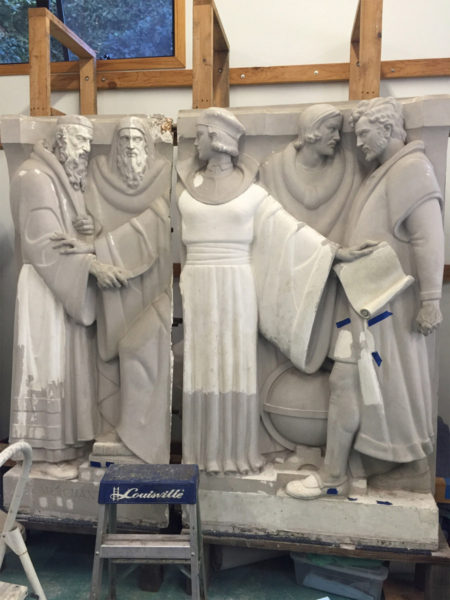Brush Up on Your Shakespeare: Repairs to Our Reliefs

A piebald plaster relief depicts Portia in Shakespeare’s “The Merchant of Venice.” Scripps conservation interns are in the process of restoring the work under the guidance of professional conservator Donna Williams.
Why Are the Shakespeare Reliefs Important?
In the 1930s, John Gregory, a famous American sculptor, used Scripps’ eight plaster bas-reliefs to cast his famous marble Shakespeare reliefs, which now reside on the north façade of the Folger Shakespeare Library in Washington, D.C. Up until the 1950s, the Folger also housed all nine of Gregory’s plaster reliefs in storage. It wasn’t until Dr. Frederick Hard—Scripps College president and Shakespeare scholar—negotiated with the library’s director that a deal was struck and Scripps acquired the eight reliefs we have today. These works are currently displayed on the walls of Sycamore Court and Balch Hall, with the exception of pieces that are being conserved.
The original marble reliefs at the Folger have encountered various conservation issues throughout the years, particularly in the form of erosion due to acid rain. As the marble loses detail, it is increasingly important that Scripps concentrates on conservation efforts for the plaster. Without the plaster reliefs, the accurate conservation of the Folger’s marble reliefs would be impossible; conservators would have to guess at Gregory’s intentions.
Laura Woods, SCR ’18
Repair Process
Conservation efforts for John Gregory’s plaster reliefs began in the spring of 2004. The first panels to undergo treatment were A Midsummer Night’s Dream and Romeo and Juliet. On first glance, each piece showed paint that cracked, flaked or lifted from the plaster substrate, exposing the already fragile plaster to outdoor elements. Throughout the years, the panels were also painted to cover discrepancies; two of them, including Romeo and Juliet, had faux finishes applied. Conservators concluded that all layers of over paint needed to be removed carefully (so as not to damage the plaster underneath). The reliefs were then to be sealed with protective resin coatings and plaster washes. Under the mentorship of LA-based conservator Donna Williams, Scripps conservation interns have been able to participate in the planning and execution of treatment plans. The Merchant of Venice is currently undergoing the prescribed treatment plan.
The conservation of these historical works has been made possible through the generosity of the Scripps Collectors’ Circle, Jim and Ann Ach ’65, Peggy Phelps, Jane Hurley Wilson ’64 and Michael G. Wilson, and the Getty Foundation.
Daniela Gonzalez-Pruitt, University of Toronto ’17 and Josephine Ren, SCR ’19
Stories Behind the Scenes
In his reliefs, John Gregory depicts the plays: A Midsummer Night’s Dream, Romeo and Juliet, The Merchant of Venice, Macbeth, King Lear, Richard III, Hamlet, and Henry IV. In A Midsummer Night’s Dream, Gregory captures the humor of one of Shakespeare’s most popular comedies by presenting the scene in which Bottom the Weaver—whose head has just been transformed into an ass’s—rests in the arms of the delicate Fairy Queen Titania.
In Romeo and Juliet, we witness the famous couple’s farewell after Romeo had been banished for killing Tybalt. The scene is in anticipation of Romeo and Juliet’s permanent parting—through death—to come. The Merchant of Venice depicts Portia (dressed as a lawyer), at the center, about to deliver her monologue on “the quality of mercy.” To the left, Shylock wields a knife, ready to collect his pound of flesh from the defendant, Antonio. Portia’s suitor and Antonio consult on the right.
In Macbeth, the protagonist stumbles into a cave to find witches gathered around a boiling cauldron. Gregory illustrates King Lear unleashing a passionate rage against the elements. The fool, who grovels before the display of anger, accompanies him. To the left of the panel, the Earl of Kent happens upon the unlikely pair. In the panel, Richard III, Richard Duke of Gloucester, the Archbishop of Canterbury, and Richard’s confidante, the Duke of Buckingham, attempt to convince two young princes to accompany them to the Tower of London. Present in Hamlet are the protagonist, his ghostly father, and his mother Queen Gertrude, to whom King Hamlet is invisible. Gertrude is convinced of Hamlet’s madness after he shrieks at this unseen entity. The Henry IV panel represents the moment during which Prince Hal confronts the trickster Falstaff for having robbed innocents. To the far right is Falstaff’s crony, Bardolph.
Laura Woods, SCR ’18
Image: John Gregory, The Merchant of Venice, 1930s, plaster bas-relief, approx. 6 x 6′, Scripps College, photo by Josephine Ren SC ’19

